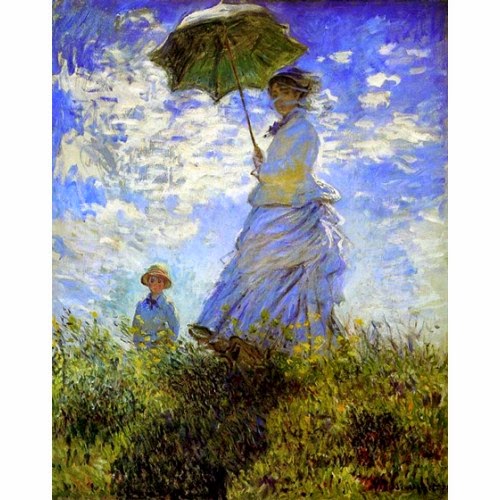'' Topsy-Turvey ''
Wednesday, April 29, 2015
Wednesday, April 22, 2015
Impressionism and Post Impressionism
Impressionism is a 19th century art movement which originated in France. Artists would create landscape paintings of what they saw which became impressionist paintings. The focus of impressionism is usually to capture the essence of light as it hits an object. Impressionist paintings consists of small and consistent brush strokes, drawing attention to the idea of movement. The artist were known as impressionists and would paint outside. Painting ouside limited their time to mix colors therefore they were forced to paint more quickly to keep up with the changing daylight. As a result their works seemed to come off as messy or unpolished. The painters focused on making the color and contrast stand out, to catch the viewers eye like it would in real life.
‘ Woman with a Parasol ‘
Claude Monet
1875
Oil paint
Post Impressionism was based of impressionism but steers away from the traditional style. Most of these painters painted in isolation. They strayed away from the naturalism of impressionism and focused more on color, lines, forms and shapes. Generalizing their perception of the image being seen and portraying it for the viewer to see as well. Each artist uniquely displayed their artistic expression through their paintings. They used the same idea as impressionists but gave it their own spin with new techniques to express their thoughts and emotion in art. This style later inspired two major movements such as cubism and fauvism.
‘ Les Vessenots ‘ in Auvers
Vincent van Gogh
1890
Oil paint
Thursday, April 9, 2015
Renaissance and Baroque Styles
Art has seen introduced the world to many styles from traditional garments to regional artwork.
Two styles that made an impact were the Renaissance and Baroque styles.
The renaissance period ran from 1300 to the 1700s. The word renaissance means ‘’ rebirth. ’’ In this time a lot of artists were entrapeneurs ranging from philosophical works to architect and human anatomy. Some famous renaissance artists consisted of Michelangelo, Donatello, Botticelli and many many more.
During the renaissance Italian architects, sculptors and painters sought to integrate christian spiritual traditions with the rational normality of physical life in an earthly space by studying light and anatomy while applying geometry to their art. Through the use of linear perspective they applied geometry to the logical construction of implied space creating depth and three dimensional visuals.
These studies and techniques led to inspire and help the growth of science.
One amazing renaissance artwork named The Tame Magpie by Alessandro Magnasco completed around 1707-8.
This painting really portrays the depth of space with receding scenery. The artists made sure that the figures in the front were large and appeared close while the figures in the back get smaller and smaller as it recedes giving the viewer a sense that the image is not flat. Another detail is that the colors seems to be stronger and bolder in the front while the background colors seem to be fading away making it seem distant and unclear.
The Baroque period was estimated to have occurred from 1600 to 1770. The Baroque were inspired by the renaissance period. Using the techniques learned and adding more drama, emotions and energy. They didn’t rely so much on geometry and harmony and balance of the figures in their art but instead they focused more on lighting, shadows and use of space. Baroque artwork is famous for their uses of curves and counter curves. The artists would use directed light and strong contrasts to guide the viewers attention and intensify the art. Naturally giving it a sense of realism.
A very intense baroque artwork I have seen is an oil on canvas titled, ‘’ The Denial of Saint Peter ‘’ by Michelangelo Merisi da Caravaggio. It was made in the year 1610. Caravaggio was an Italian painter.
The painting depicts Peter denying Jesus after his arrest. This is a perfect example of baroque style from the lighting to emotion on the subjects faces. The light is focused on key body parts which detail the facial expression and sentiment. You can see the wrinkles of stress in Peters forehead and the look of uncertainty in the woman face staring at the guard. It gives the viewer the feeling that they are witnessing an argument and worry from Peters end.
These great periods have inspired many works and it is truly a blessing to have these works and teachings for the knowledge and insight they share!
Subscribe to:
Comments (Atom)




